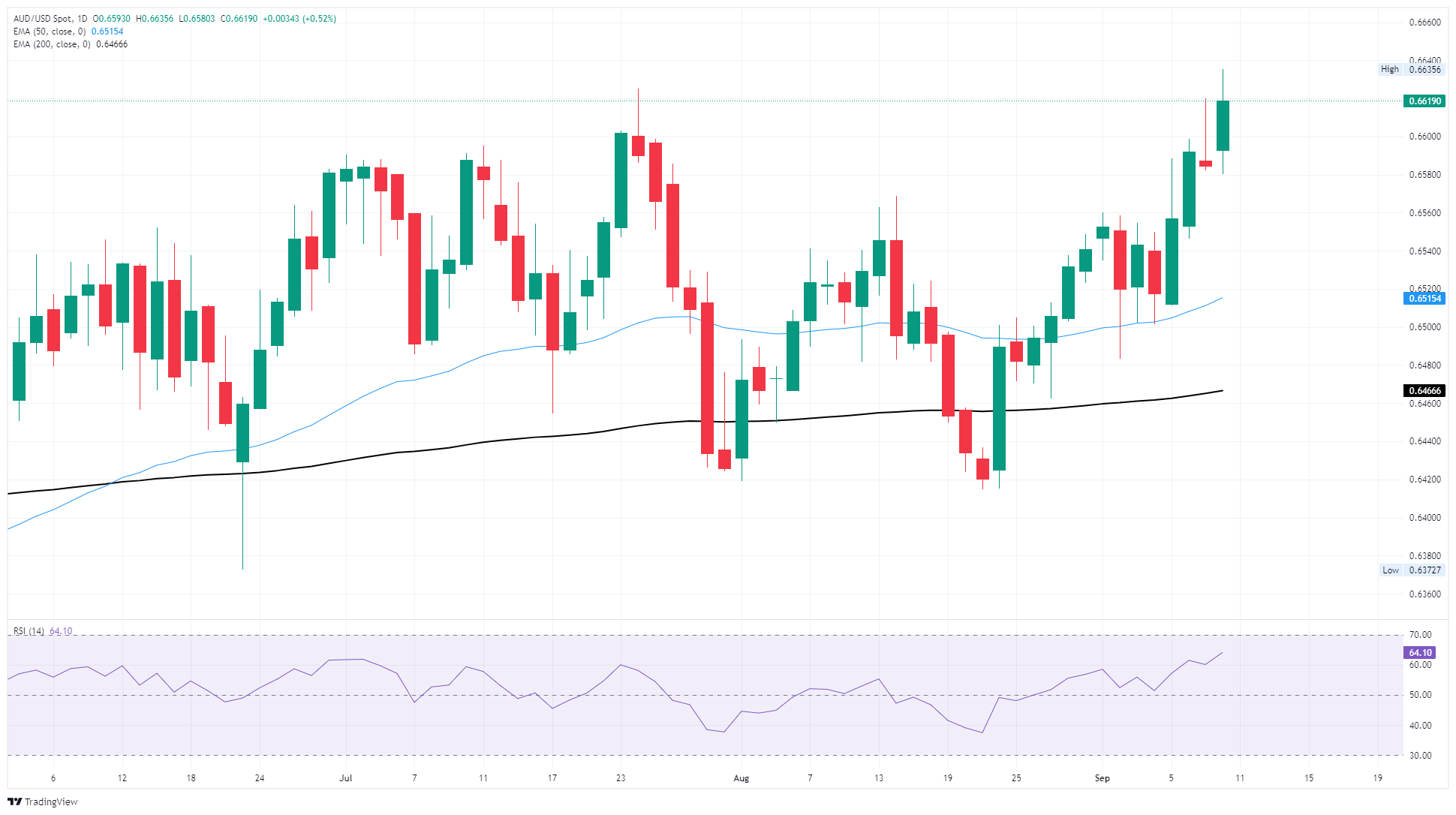AUD/USD toys with ten-month high ahead of US CPI inflation print
- AUD/USD tested a ten-month peak on Wednesday as the Aussie continues to climb.
- The Australian Dollar gained another half-percent as markets lean into Fed rate cut bets.
- The latest round of US CPI inflation is unlikely to shift the Fed away from a cut, but could still complicate policy.
AUD/USD rose into its highest bids in ten months on Wednesday, tapping the 0.6635 region for the first time since November of last year. The Aussie caught a firm bid through the day, driven by a general buoyancy to market risk appetite. The Federal Reserve (Fed) is on rails, heading toward a September rate cut after this week’s US Producer Price Index (PPI) inflation print showed that US businesses are not facing inflation pressures, at least not domestically.
Chinese CPI inflation eased in August, which is hardly surprising. Chinese inflation metrics are driven entirely by domestic demand, which has continued to stumble through several stimulus projects by the Chinese government. The next round of US CPI inflation is due on Thursday, and is expected to show another uptick in headline consumer-facing inflation. With tariff pressures and the end of small-scale shipping de minimis exemptions, ongoing consumer-level inflation pressures are certainly unsurprising.
The trading week will wrap up with another round of the University of Michigan Consumer Sentiment Index, which is expected to tick down to 58.0 from 58.2. Michigan 1-year and 5-year Consumer Inflation Expectations continue to run high, with the 1-year last clocking in at 4.8% and the 5-year horizon still holding at 3.5%.
AUD/USD daily chart

Australian Dollar FAQs
One of the most significant factors for the Australian Dollar (AUD) is the level of interest rates set by the Reserve Bank of Australia (RBA). Because Australia is a resource-rich country another key driver is the price of its biggest export, Iron Ore. The health of the Chinese economy, its largest trading partner, is a factor, as well as inflation in Australia, its growth rate and Trade Balance. Market sentiment – whether investors are taking on more risky assets (risk-on) or seeking safe-havens (risk-off) – is also a factor, with risk-on positive for AUD.
The Reserve Bank of Australia (RBA) influences the Australian Dollar (AUD) by setting the level of interest rates that Australian banks can lend to each other. This influences the level of interest rates in the economy as a whole. The main goal of the RBA is to maintain a stable inflation rate of 2-3% by adjusting interest rates up or down. Relatively high interest rates compared to other major central banks support the AUD, and the opposite for relatively low. The RBA can also use quantitative easing and tightening to influence credit conditions, with the former AUD-negative and the latter AUD-positive.
China is Australia’s largest trading partner so the health of the Chinese economy is a major influence on the value of the Australian Dollar (AUD). When the Chinese economy is doing well it purchases more raw materials, goods and services from Australia, lifting demand for the AUD, and pushing up its value. The opposite is the case when the Chinese economy is not growing as fast as expected. Positive or negative surprises in Chinese growth data, therefore, often have a direct impact on the Australian Dollar and its pairs.
Iron Ore is Australia’s largest export, accounting for $118 billion a year according to data from 2021, with China as its primary destination. The price of Iron Ore, therefore, can be a driver of the Australian Dollar. Generally, if the price of Iron Ore rises, AUD also goes up, as aggregate demand for the currency increases. The opposite is the case if the price of Iron Ore falls. Higher Iron Ore prices also tend to result in a greater likelihood of a positive Trade Balance for Australia, which is also positive of the AUD.
The Trade Balance, which is the difference between what a country earns from its exports versus what it pays for its imports, is another factor that can influence the value of the Australian Dollar. If Australia produces highly sought after exports, then its currency will gain in value purely from the surplus demand created from foreign buyers seeking to purchase its exports versus what it spends to purchase imports. Therefore, a positive net Trade Balance strengthens the AUD, with the opposite effect if the Trade Balance is negative.

